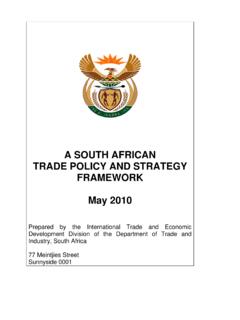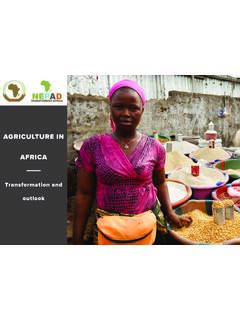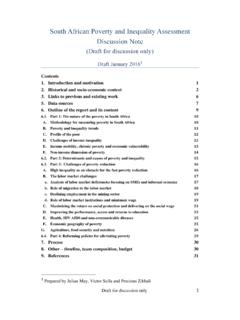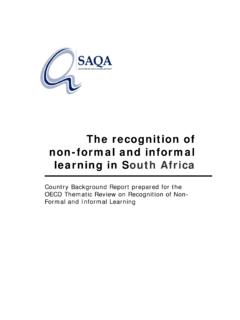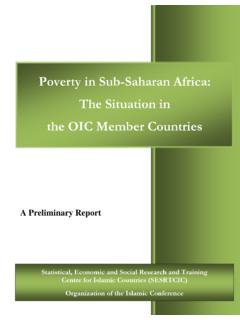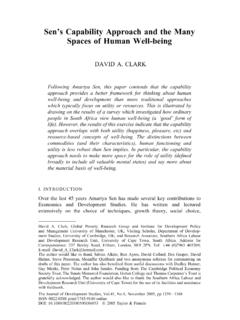Transcription of South Africa’s National Development Plan and its ...
1 South Africa's National Development Plan and its implications for regional Development by Harry Zarenda WORKING PAPER. tralac Working Paper No. D13WP01/2013. June 2013. Please consider the environment before printing this publication | | Twitter @tradelawcentre | Copyright tralac, 2013. Readers are encouraged to quote and reproduce this material for educational, non-profit purposes, provided the source is acknowledged. All views and opinions expressed remain solely those of the authors and do not purport to reflect the views of tralac. Copyright tralac, 2013. Readers are encouraged to quote and reproduce this material for educational, non-profit purposes, provided the source is acknowledged. All views and opinions expressed remain solely those of the authors and do not purport to reflect the views of tralac This publication should be cited as: Zarenda, H.
2 2013. South Africa's National Development Plan and its implications for regional Development . Stellenbosch: tralac. tralac gratefully acknowledges the financial support of the Danish International Development Assistance (Danida) for the publication of this Working Paper | | Twitter @tradelawcentre Readers are encouraged to quote and reproduce this material for educational, non-profit purposes, provided the source is acknowledged. All views and opinions expressed remain solely those of the authors and do not purport to reflect the views of tralac. South Africa's National Development Plan and its implications for regional Development tralac Working Paper | D13WP01/2013 | Author: Harry Zarenda South Africa's National Development Plan and its implications for regional Development by Harry Zarenda Introduction In 2012/2013, the African National Congress and South African Government adopted the National Development Plan (NDP) as its launchpad and blueprint for a future economic and socioeconomic Development strategy for the country.
3 Supposedly incorporating both the more recent Department of Trade and Industry's (DTI) Industrial Policy Action Plan (IPAP) and the Economic Development Ministry's New Growth Path (NGP) into the new National Planning Framework, the NDP has critical and important implications for the various regional economic communities in southern Africa at present. The purpose of this contribution is to provide an overview and assessment of these possible implications . Background to the NGP. Since 2010 the South African Government has introduced various policy initiatives which have formed the basis of industrial policy in the country. The incipient plan at that time was the 2010/2011- 2012/13 Industrial Policy Action Plan (IPAP2), released in February 2010 by the DTI, which in turn represented a modification and update of the previously introduced initial IPAP (2007) strategy.
4 This second version attempted to focus on strategic efforts to diversify, intensify and enhance the domestic and international competitiveness of the country's industrial sector. The New Growth Path (NGP) document, released later in the year in December 2010 by the Economic Development Minister, Ebrahim Patel, set job creation as a dominant priority in the country, with the aim of reducing levels of unemployment by some 10 percentage points by 2020. The NGP prioritised six areas for job creation- infrastructure Development , agriculture, mining, manufacturing, tourism and a green' economy. The NGP also indicated a strong emphasis on social equity and competitiveness, fundamental changes to mobilise domestic investment in sustainable industries and a social dialogue to focus all stakeholders on directing growth towards employment-creating activities.
5 In May 2010, President Jacob Zuma appointed the National Planning Commission (NPC), under the Chairmanship of the Minister in the Presidency for National Planning, Trevor Manuel, to draft a 1. South Africa's National Development Plan and its implications for regional Development tralac Working Paper | D13WP01/2013 | Author: Harry Zarenda vision and National Development plan for consideration by Cabinet and the country. The NPC. represented an advisory body consisting of 26 people drawn largely from outside government, chosen for their expertise in key areas' ( National Planning Commission, 2011: 15 Executive Summary). The Commission released a Diagnostic Report in June 2011 which set out South Africa's achievements and shortcomings since 1994' and set out nine primary challenges, listed in the executive report (Ibid).
6 Including inter alia chronic unemployment, poor education and infrastructure, an economy which is 'unsustainably resource intensive', inadequate and poor quality public health and general public services, high levels of corruption and a society which was deeply divided. Building on the diagnostic report ( National Planning Commission Diagnostic Report 2011) and subsequent public comment, a draft Development plan was released in November 2011 which added four thematic areas to the above list a focus on the rural economy, social protection, regional /world affairs and community safety. Extensive consultations and comments on the draft plan were forthcoming and the overall response was, in general, positive. The plan was endorsed by the ruling party at its Manguang Conference in December 2012 and after being very favourably considered by Cabinet, formed the basis of President Zuma's State of the Nation address in the opening of Parliament on 14 February 2013.
7 To assess the seriousness that the South African Government is placing on the NDP one can reflect on how it has influenced the presentation of the Minister of Finance's most recent budget speech ( South Africa, Treasury 2013) in which the plan was referred to as a new strategic framework at the core of South Africa's future leap forward'. A broad outline of the plan This section of the discussion paper will present a brief summary of the essential elements of the plan. At the outset, it must be emphasised that the full text of the plan ( National Planning Commission, 2011) comprises a 444-page document, daunting to say the least, and contains considerable details that are spelled out in each of the chapters dealing with specific issues. The relevant issues pertaining to the region based on the more detailed full text will be focused on in a later section in this paper For present purposes (and to provide a broad understanding of the outline of the plan), the overall objectives of the plan, its vision and suggested implementation, are abstracted from the shorter 70- page Executive Summary ( National Planning Commission, 2011, Executive Summary) and the Post- 2.
8 South Africa's National Development Plan and its implications for regional Development tralac Working Paper | D13WP01/2013 | Author: Harry Zarenda State of the Nation (SoNA) media briefing by Ministers Trevor Manuel and Collins Chabane ( South African Government Information (SAGI) Release, 19 February 2013). The strategic perspective of the NDP offers a long-term vision for the country (until 2030) and aims to ensure that all South Africans attain a decent standard of living through the elimination of poverty and the reduction of inequality' (SAGI-SoNA, 2013: 1). The core elements of a decent standard of living identified in the plan are: housing, water electricity and sanitation safe and reliable public transport quality education and skills Development safety and security quality health care social protection employment recreation and leisure clean environment adequate nutrition.
9 There are four overriding implementational objectives of the plan and these are stipulated as (SAGI- SoNA, 2013: 1): i) providing overarching goals for what is to be achieved by 2030. ii) building consensus on the key obstacles for achieving these goals and identifying what needs to be done to overcome these obstacles. iii) providing a shared long-term strategic framework within which more planning can take place in order to advance the long term goals set out in the NDP. iv) creating a basis for making choices about how best to use limited resources. 3. South Africa's National Development Plan and its implications for regional Development tralac Working Paper | D13WP01/2013 | Author: Harry Zarenda The plan is explicit and very specific in listing its poverty reduction objectives by 2030: - reducing the number of people who live in households below the R419 (in 2009 prices) from 39% to zero - a reduction in income inequality (using the Gini Coefficient measure) from 0,69 to 0,6 over this time period - employment to be raised (from 13 million in 2010 to 24 million in 2030).
10 - per capita incomes to be increased from R50,000 in 2010 to R120,000 and shares of National income of the bottom 40% ( from 6% to 10%) by 2030. In addition the plan (Ibid. adapted) lists manifold objectives such as: establishing a competitive base of infrastructure, human resources and regulatory frameworks matching skilled, technical, professional and managerial posts to better reflect the country's racial, gender and disability profile broadening asset ownership to historically disadvantaged groups increasing the quality of primary education providing affordable health care while promoting health and well-being providing safe and affordable public transport producing sufficient energy to support industry, at competitive prices ensuring access to such energy for poor households and reducing power emissions by one-third ensuring access to clean running water for all maintaining a competitively-priced high-speed broadband internet universally realising a food surplus with one-third being produced by small-scale farmers or households ensuring household food and nutrition security providing social protection for the poor and needy through an entrenched social security system 4.
